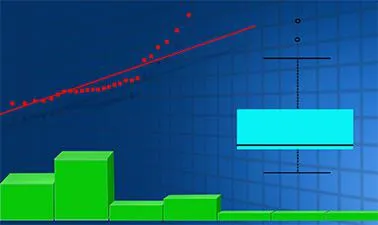
Biostatistics Tutorial Full course for Beginners to Experts 
Biostatistics is a comprehensive course for learners of all levels. It covers topics such as introduction to statistics, describing data shape, central tendency, variability, z-scores and probability. It also provides an in-depth understanding of hypothesis testing, correlation and regression. The course is designed to equip learners with the necessary skills to understand and apply biostatistics in their field. ▼
ADVERTISEMENT
Course Feature
![]() Cost:
Cost:
Free
![]() Provider:
Provider:
Youtube
![]() Certificate:
Certificate:
Paid Certification
![]() Language:
Language:
English
![]() Start Date:
Start Date:
On-Demand
Course Overview
❗The content presented here is sourced directly from Youtube platform. For comprehensive course details, including enrollment information, simply click on the 'Go to class' link on our website.
Updated in [February 21st, 2023]
Module 1 - Introduction to Statistics.
Module 2 - Describing Data: Shape.
Module 3 - Describing Data: Central Tendency.
Module 4 - Describing Data: Variability.
Module 5 - Describing Data: Z-scores.
Module 6 - Probability (part I).
Module 6 - Probability (part II).
Module 7 - Distribution of Sample Means.
Module 9 - Estimation & Confidence Intervals & Effect Size.
Module 10 - Misleading with Statistics.
Module 11 - Biostatistics in Medical Decision-making.
Module 11b - Biostatistics in Medical Decision-Making: Clinical Application.
Module 12 - Biostatistics in Epidemiology.
Module 13 - Asking Questions: Research Study Design.
Module 14 - Bias & Confounders.
Module 16 - Correlation & Regression.
Module 17 - Non-parametric Tests.
(Please note that we obtained the following content based on information that users may want to know, such as skills, applicable scenarios, future development, etc., combined with AI tools, and have been manually reviewed)
This Biostatistics Tutorial Full Course for Beginners to Experts is an excellent way to learn the fundamentals of biostatistics. It covers a wide range of topics, from basic concepts such as describing data, probability, and distributions, to more advanced topics such as estimation, confidence intervals, effect size, and research study design. It also covers topics related to medical decision-making, epidemiology, bias and confounders, correlation and regression, and non-parametric tests. This course is suitable for both beginners and experts, as it provides a comprehensive overview of biostatistics and its applications. Learners can gain a better understanding of the fundamentals of biostatistics, as well as gain the skills to apply biostatistics in their own research. They can also learn how to interpret and analyze data, and how to design and conduct research studies. Furthermore, learners can gain an understanding of the ethical considerations related to biostatistics, and how to avoid common pitfalls in data analysis. This course is an invaluable resource for anyone interested in learning more about biostatistics.
[Applications]
After completing this course, learners can apply their knowledge of biostatistics to medical decision-making, epidemiology, research study design, and more. They can use their understanding of probability, distributions, estimation, confidence intervals, effect size, and correlation and regression to analyze data and draw meaningful conclusions. They can also use their knowledge of bias and confounding to identify and address potential sources of error. Finally, they can use their understanding of non-parametric tests to analyze data when assumptions of normality are not met.
[Career Paths]
1. Biostatistician: Biostatisticians use statistical methods to analyze data related to health and medicine. They develop and apply statistical models to analyze data from clinical trials, epidemiological studies, and other research projects. They also provide advice on study design, data collection, and data analysis. As the demand for healthcare services increases, the need for biostatisticians is expected to grow.
2. Data Scientist: Data scientists use data to develop insights and solutions to complex problems. They use a variety of techniques, such as machine learning, to analyze large datasets and uncover patterns and trends. Data scientists are in high demand in the healthcare industry, as they can help to identify new treatments and improve patient outcomes.
3. Clinical Research Coordinator: Clinical research coordinators are responsible for managing clinical trials and research studies. They are responsible for recruiting participants, collecting data, and ensuring that the study is conducted in accordance with ethical and regulatory guidelines. As the demand for clinical trials increases, the need for clinical research coordinators is expected to grow.
4. Health Informatics Specialist: Health informatics specialists use technology to improve healthcare delivery. They develop and maintain electronic health records, design and implement health information systems, and analyze data to improve patient outcomes. As healthcare organizations increasingly rely on technology, the demand for health informatics specialists is expected to grow.
[Education Paths]
1. Bachelor of Science in Biostatistics: This degree program provides students with a comprehensive understanding of biostatistical methods and techniques, including data analysis, statistical modeling, and research design. Students learn to apply these methods to a variety of fields, such as public health, epidemiology, and clinical research. The degree also covers topics such as probability, sampling, and statistical computing. Developing trends in this field include the use of machine learning and artificial intelligence to analyze large datasets.
2. Master of Science in Biostatistics: This degree program provides students with advanced training in biostatistical methods and techniques. Students learn to apply these methods to a variety of fields, such as public health, epidemiology, and clinical research. The degree also covers topics such as probability, sampling, and statistical computing. Developing trends in this field include the use of machine learning and artificial intelligence to analyze large datasets.
3. Doctor of Philosophy in Biostatistics: This degree program provides students with an in-depth understanding of biostatistical methods and techniques. Students learn to apply these methods to a variety of fields, such as public health, epidemiology, and clinical research. The degree also covers topics such as probability, sampling, and statistical computing. Developing trends in this field include the use of machine learning and artificial intelligence to analyze large datasets.
4. Master of Public Health in Biostatistics: This degree program provides students with an understanding of biostatistical methods and techniques, as well as an understanding of public health principles and practices. Students learn to apply these methods to a variety of fields, such as public health, epidemiology, and clinical research. The degree also covers topics such as probability, sampling, and statistical computing. Developing trends in this field include the use of machine learning and artificial intelligence to analyze large datasets.
Course Provider

Provider Youtube's Stats at AZClass
Discussion and Reviews
0.0 (Based on 0 reviews)
Explore Similar Online Courses

MongoDB Crash Course

Simple Stories For Great Wisdom From a Visual Story Teller

Python for Informatics: Exploring Information

Social Network Analysis

Introduction to Systematic Review and Meta-Analysis

The Analytics Edge

DCO042 - Python For Informatics

Causal Diagrams: Draw Your Assumptions Before Your Conclusions

Whole genome sequencing of bacterial genomes - tools and applications

Doing Clinical Research: Biostatistics with the Wolfram Language

Introduction to Applied Biostatistics: Statistics for Medical Research


Start your review of Biostatistics Tutorial Full course for Beginners to Experts